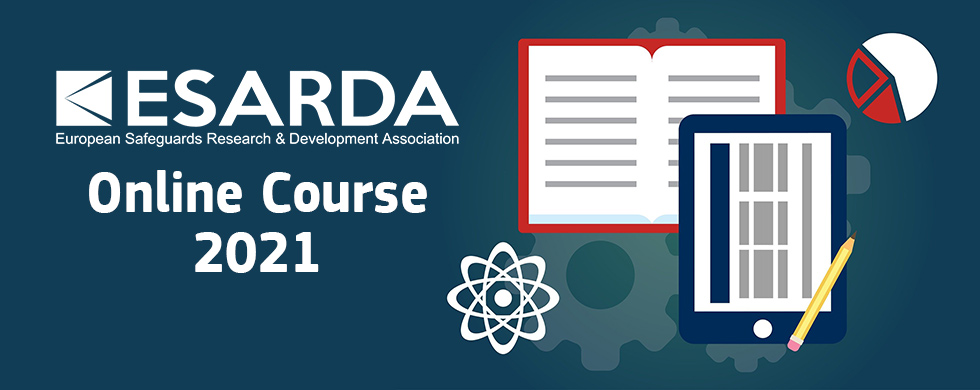The JRC Announces the 19th ESARDA COURSE on Nuclear Safeguards and Non Proliferation to be held in spring 2021, co-organised by the European Commission's Joint Research Centre and the ESARDA TKM Working Group.
Organised by the European Safeguards Research & Development Association, Working Group on Training, Knowledge Management
Hosted by the Nuclear Security Unit, Joint Research Centre Ispra, Italy
- nuclear non-proliferation
- Monday 12 April 2021, 09:00 - Friday 16 April 2021, 17:00 (CEST)
- Live streaming available
Practical information
- When
- Monday 12 April 2021, 09:00 - Friday 16 April 2021, 17:00 (CEST)
- Languages
- English
Description

Important
Participation to the course is subject to acceptance by the course organisers after the screening of the submitted registration forms. Submitting a registration form does not imply that you are entitled to attend the course, as a maximum number of 60 participants is allowed. Before booking your travel arrangements, make sure you have received a written confirmation by the organiser stating your acceptance to participate.
Origin of the course
The knowledge retention problem in the nuclear field was acknowledged by the OECD in 2000. The United Nations study on disarmament and non-proliferation education (2002) made detailed recommendations for urgently required improvements. ESARDA, the European Safeguards Research and Development Association, reacted to these shortcomings with a strategy to tackle the problem and created a Working Group on Training and Knowledge Management (ESARDA WG TKM). The final objective of the ESARDA WG TKM is the setup of academic course modules to an internationally recognised reference standard. This project is in line with the movement of establishing a European curriculum for Nuclear Engineering. Teaching in the Nuclear Safeguards field is indeed strongly influenced by national history so the objective of the course is to provide homogeneous material in Nuclear Safeguards and Non-Proliferation matters at the European and international level.
Learning objectives
This compact course is open to masters degree students, in particular nuclear engineering students, but also to young professionals and International Relations / law students. It aims at complementing nuclear engineering studies by including nuclear safeguards in the academic curriculum. The basic aim of the course is to stimulate students’ interests in safeguards. The course addresses aspects of the efforts to create a global nuclear nonproliferation system and how this sytem works in practice: the Treaty on Nonproliferation of Nuclear Weapons (NPT), safeguards technology, and export control. Also regional settings, such as Euratom Treaty, are presented and discussed. The course deals in particular with technical aspects and application of safeguards; i.e. how to implement the safeguards principles and methodology within the different nuclear facilities. Therefore the course will create an overview on inspections techniques, ranging from neutron / gamma detectors, to design information verification, to environmental sampling, etc.
Course content
Introduction
The evolution of the Non Proliferation Treaty —regime, safeguards, international control regimes in theory and practice, and present trends in the nuclear nonproliferation efforts.
What is safeguarded
Definition of nuclear material that is subject to nuclear safeguards and related safeguards goals (significant quantity, timeliness and detection probabilities).
Where is it found
Description of the nuclear fuel cycle from mining to final repository, focussing on enrichment in the front-end and reprocessing in the back-end.
Which legal protection means exist
Overview on international and regional Non-Proliferation Treaties and established Institutions and Organisations.
What is the methodology to verify
Nuclear material accountancy principles and statistics of auditing.
How are inspections performed
Overview on inspector tools and their use to verify the nuclear activities as declared under the safeguards agreements (Non Destructive Assay, Monitoring, Containment / Surveillance); additional safeguards measures under the Additional Protocol (complementary access, satellite imagery, environmental sampling) and how they are applied in field (storage facility, process facility, enrichment facility, research institute, spent fuel transfer).
How to control Import / Export
Guidelines of the Nuclear Suppliers Group, trigger list and dual-use list. Means to combat illicit trafficking, inclusive nuclear forensics.
What additional information offers
Collection of open source data and demonstration of some case studies (Iraq, 1993).
Practical organisation
The course features a full five-days program with 1h lectures by experts in the field of nuclear safeguards, virtual visits to five safeguards laboratories and some classroom exercises.
The course material, consisting of a complete set of presentations and literature will be provided to the participants. It is recommended that the students prepare themselves with the reading material on the website.
The registration will be soon available on the JRC online registration system, which will be shortly available.
All participants are encouraged to make an essay on a given topic selected from the list, which is handed out at the end of the course. Up to 2 best essays can be selected for being published in 'The Connector', ESARDA's official Newsletter.
Students can include this course, which can be recognised by BNEN / ENEN for 3ECTS, in their academic curriculum. To be quoted for this course an additional Take-Home-Exam is foreseen.
Contacts
General contact
JRC NUSAF SECRETARIAT
- Name
- JRC NUSAF SECRETARIAT
- Organisation
- JRC-NUSAF-SECRETARIAT@ec.europa.eu
